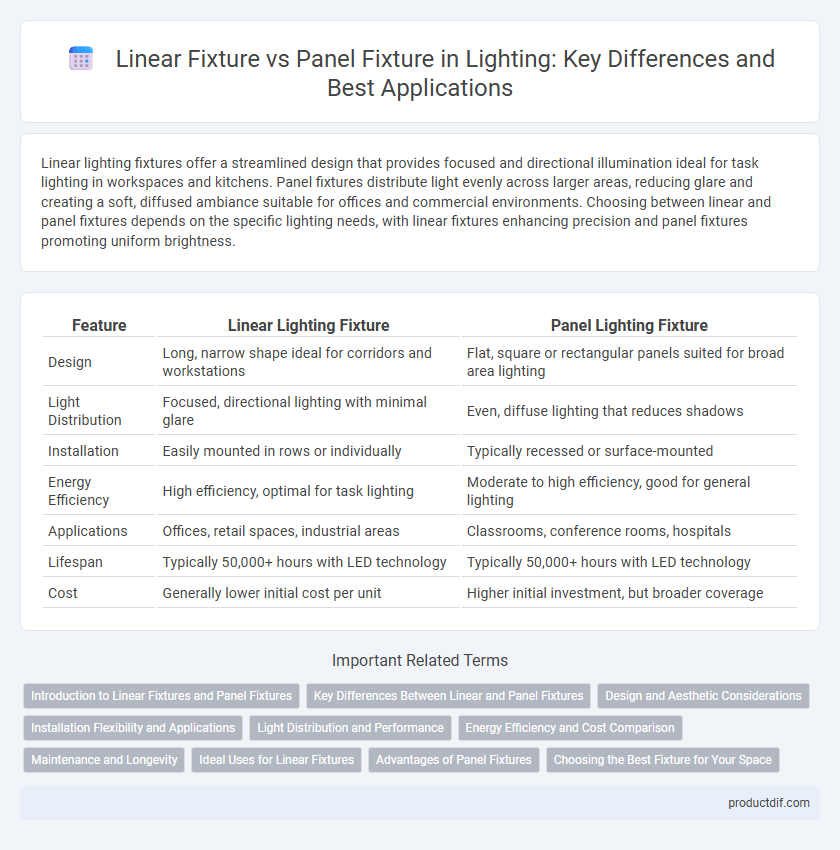Linear lighting fixtures offer a streamlined design that provides focused and directional illumination ideal for task lighting in workspaces and kitchens. Panel fixtures distribute light evenly across larger areas, reducing glare and creating a soft, diffused ambiance suitable for offices and commercial environments. Choosing between linear and panel fixtures depends on the specific lighting needs, with linear fixtures enhancing precision and panel fixtures promoting uniform brightness.
Table of Comparison
| Feature | Linear Lighting Fixture | Panel Lighting Fixture |
|---|---|---|
| Design | Long, narrow shape ideal for corridors and workstations | Flat, square or rectangular panels suited for broad area lighting |
| Light Distribution | Focused, directional lighting with minimal glare | Even, diffuse lighting that reduces shadows |
| Installation | Easily mounted in rows or individually | Typically recessed or surface-mounted |
| Energy Efficiency | High efficiency, optimal for task lighting | Moderate to high efficiency, good for general lighting |
| Applications | Offices, retail spaces, industrial areas | Classrooms, conference rooms, hospitals |
| Lifespan | Typically 50,000+ hours with LED technology | Typically 50,000+ hours with LED technology |
| Cost | Generally lower initial cost per unit | Higher initial investment, but broader coverage |
Introduction to Linear Fixtures and Panel Fixtures
Linear fixtures offer elongated, narrow designs ideal for uniform lighting in office spaces, corridors, and retail environments, enhancing visual comfort and energy efficiency. Panel fixtures feature a flat, square or rectangular design providing wide, even light distribution suitable for suspended ceilings and open-plan areas. Both fixtures support LED technology, contributing to modern, sustainable lighting solutions with customizable brightness and color temperatures.
Key Differences Between Linear and Panel Fixtures
Linear fixtures provide focused, directional lighting ideal for task-oriented environments, featuring elongated designs that distribute light evenly along a narrow path. Panel fixtures emit uniform, wide-area illumination with a flat, broad surface, enhancing ambient lighting without harsh shadows. The choice between linear and panel fixtures depends on spatial requirements, lighting intensity, and application-specific needs such as office workspaces versus open areas.
Design and Aesthetic Considerations
Linear fixtures offer sleek, elongated profiles that enhance architectural lines and create a modern, streamlined aesthetic suitable for contemporary interiors. Panel fixtures provide a uniform, diffused light surface that blends seamlessly with ceilings, ideal for minimalist designs and creating an unobtrusive lighting scheme. Choosing between linear and panel fixtures depends on the desired visual impact, spatial layout, and integration with interior elements.
Installation Flexibility and Applications
Linear fixtures offer superior installation flexibility with customizable lengths and the ability to create continuous runs, making them ideal for offices, retail spaces, and architectural accents. Panel fixtures provide uniform light distribution with simple, flat designs suited for drop ceilings and clean, modern aesthetics in conference rooms and healthcare facilities. Both fixture types support energy-efficient LED technology, but linear fixtures excel in dynamic layouts while panel fixtures prioritize easy ceiling grid integration.
Light Distribution and Performance
Linear fixtures provide uniform light distribution ideal for task lighting and corridors, ensuring consistent illumination along their length. Panel fixtures deliver diffuse, even light across broader areas, minimizing glare and shadows in open office or commercial spaces. Performance-wise, linear fixtures excel in directional lighting efficiency, while panel fixtures offer superior ambient light quality and energy savings.
Energy Efficiency and Cost Comparison
Linear fixtures typically offer higher energy efficiency due to their focused light distribution, reducing power consumption compared to panel fixtures that emit diffuse light over larger areas. The initial cost of linear fixtures is often lower, but panel fixtures can provide longer lifespans and lower maintenance expenses, potentially reducing total cost of ownership. Energy consumption metrics show linear fixtures average 15-20% less kWh usage per square foot, while panel fixtures excel in uniform illumination suitable for large spaces.
Maintenance and Longevity
Linear fixtures generally offer easier maintenance due to their modular design, allowing for quick replacement of individual components without dismantling the entire unit. Panel fixtures typically have sealed designs that protect internal parts, resulting in longer lifespan and reduced wear from dust and debris. Both fixture types benefit from LED technology, but panel fixtures often provide superior longevity because of better heat dissipation and enclosed circuitry.
Ideal Uses for Linear Fixtures
Linear fixtures provide focused, directional illumination ideal for task lighting in offices, retail spaces, and industrial environments. Their elongated design ensures even light distribution along workstations, hallways, and corridors, minimizing shadows and glare. Compared to panel fixtures, linear fixtures excel in applications requiring precise control over light spread and intensity.
Advantages of Panel Fixtures
Panel fixtures offer superior uniform light distribution, minimizing shadows and glare in workspaces. Their slim design allows for easy integration into modern ceilings, providing aesthetic appeal and space efficiency. Energy efficiency and compatibility with advanced LED technology further enhance panel fixtures' cost-effectiveness and longevity.
Choosing the Best Fixture for Your Space
Linear fixtures deliver uniform, directional lighting ideal for workspaces, hallways, and areas requiring focused illumination, enhancing task visibility and reducing eye strain. Panel fixtures provide broad, diffused light that creates a soft, even glow, perfect for offices, conference rooms, and environments needing glare-free ambiance. Selecting the best fixture depends on the space's function, desired light distribution, and aesthetic preferences to achieve optimal comfort and efficiency.
Linear fixture vs panel fixture Infographic

 productdif.com
productdif.com